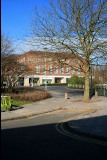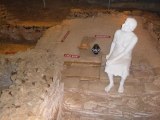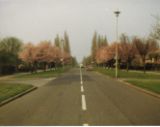Welwyn Garden City in Hertfordshire – New Town with Roman and Medieval Roots
Before migrating to Australia, we lived for 5 years in Welwyn Garden City, where I had spent a memorable year as a German assistant in 1980/81. Welwyn Garden City is in Hertfordshire, so I started wondering what Ricardian or Yorkist connections I could discover in that county and these will be discussed over time.
But I would like to start with Welwyn Garden City itself. On a purely personal level the town is of great Ricardian relevance: In autumn 1980 I bought in what was then the Welwyn Department Store (now part of the John Lewis Partnership) my copy of Josephine Tey’s The Daughter of Time, so you could say that was where my obsession with this king and the period began.

Welwyn Garden City, John Lewis (© Copyright David Lally and licensed for reuse under this Creative Commons Licence)
On a historical level though, I had to dig a bit to find anything with a Yorkist connection. As the name indicates, it is a new town, built in the 1920s. Up to 1919 the area that is now covered by the town was very sparsely populated, especially when considering its fairly close distance to London (about 30 km to the north, for a map click here). Nearby Hatfield was then the important town.
There is evidence of Roman settlement in the area and you can visit the Roman baths. The bath house remains are a scheduled ancient monument, ingeniously preserved in a steel vault under the A1(M) motorway. Once part of a fine villa, the layout of the cold, warm and hot rooms and the heating system are remarkably preserved. Also on display are archaeological finds from the Welwyn area and an exhibition devoted to the history of the site, which was uncovered during the 1960s and 70s by the Welwyn Archaeological Society.(1)

Welwyn Garden City, Roman Baths (Cold Bath) (© Copyright Christine Johnstone and licensed for reuse under this Creative Commons Licence)
However, by the early 20th century the area was mainly agricultural land with a large wooded area, Sherrards Wood. This formed part of a large hunting ground of kings and feudal lords.(2)
In 1919 the then owner of Panshanger Estate, Lord Desborough, sold a great part of his land by auction, much of this was bought by Sir Ebenezer Howard and others as the site for their second garden city (after Letchworth). It is said when Lord Desborough found out who had bought the land and for what ends, he and his wealthy landowning friends were not very happy to see ‘their beloved countryside turned into a teeming town of ‘cockneys’.” (3) To the supporters of the new town however, these were the “Hertfordshire Highlands … where the air is clean and pure, for a happy healthy life”. (4)
The manor of Panshanger is first mentioned in 1247. In the time of interest to us the rights to the manor belonged to Sir John Barre, kt., of Knebworth, through his wife Idonea, daughter of John Hotoft. Sir John Barre died in 1483 and his property descended to his daughter Isabel, widow of Humphrey Stafford Earl of Devon (beheaded in 1469) and wife of Thomas Bourchier, younger son of the Earl of Essex. She died childless in 1489. During this time the estate was held Thomas Birch and his wife Ellen, who in 1492 conveyed it to Simon Paxman and Nicholas Larwood. It is assumed that this was in trust for Sir William Say, because when his granddaughter and heiress Gertrude was beheaded in 1539, her attainder states the forfeiture of the Panshanger estate to the crown. Henry VIII then granted the manor in 1546 to the famous Nicholas Throckmorton, then sewer to Queen Katherine. (5)
Another portion of land of what now forms Welwyn Garden City used to be Woodhall Park.(6) This was held of the manor of Hatfield. From the 13th century until 1535 Woodhall descended in the Bassingbourne family.(7) In the late 15th century it was held by Thomas Bassingbourne, who was married to Katherine, the sister of the already mentioned Sir William Say.(8)
The Say family is closely related to Hertfordshire and we will meet them at a lot of places. Therefore they will be investigated in more depth in a separate article. It seems that they were Yorkist supporters and on good terms with Richard, both before and after his coronation. As it turned out, even if initially a Ricardian connection with a new town seemed far fetched, there was a connection between Richard and his affinity and Welwyn Garden City after all.
Notes:
1. Welwyn Hatfield Borough Council [accessed 17 May 2010]
2. Roger Filler, A History of Welwyn Garden City. Phillimore & Co. Ltd., Chichester, 1986. ISBN 85033 590 6. P. 173.
3. Filler, pp. 12-14
4. Filler, p. 17
5. Victoria County History, ‘Parishes: St. Andrew Rural’, A History of the County of Hertford: volume 3 (1912), pp. 468-472 [accessed 11 May 2010]
6. Anne Rowe, Medieval Parks of Hertfordshire. University of Hertfordshire Press, Hatfield, 2009. ISBN 978 1 905313 48 8. P. 119
7. Victoria County History, ‘Parishes: Hatfield‘, A History of the County of Hertford: volume 3 (1912), Woodhall, pp. 91-111 [accessed 27 Jan 2010]
8. Rowe, p. 118
Tags: Contemporaries, Hertfordshire



Leave a reply